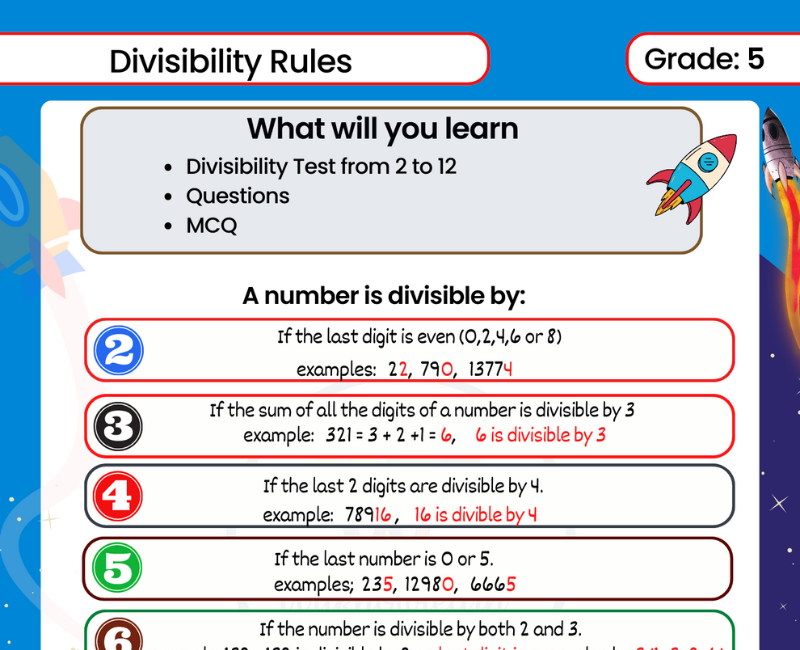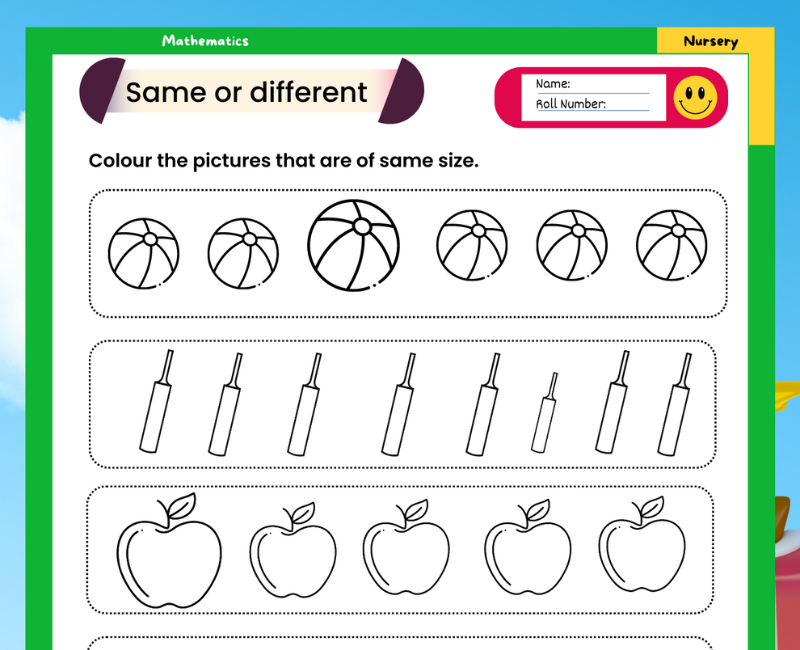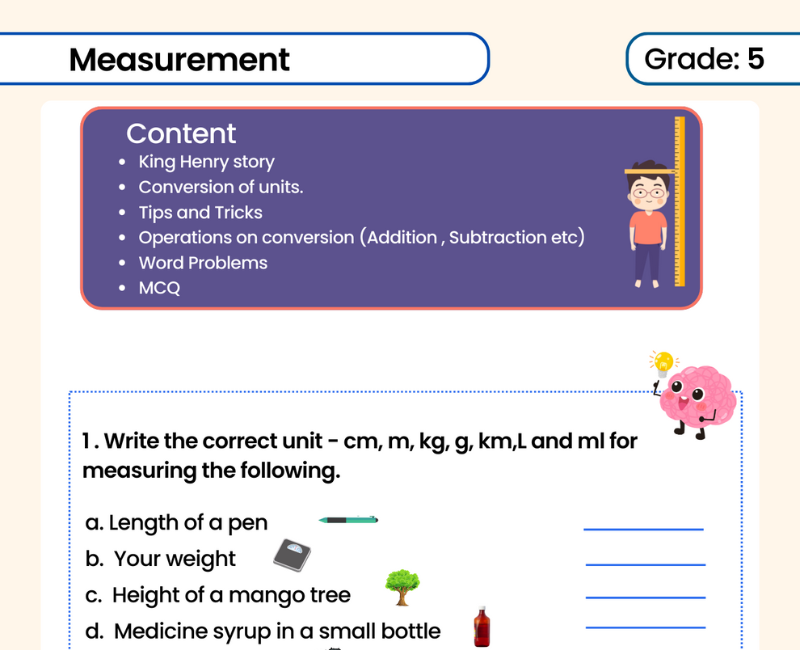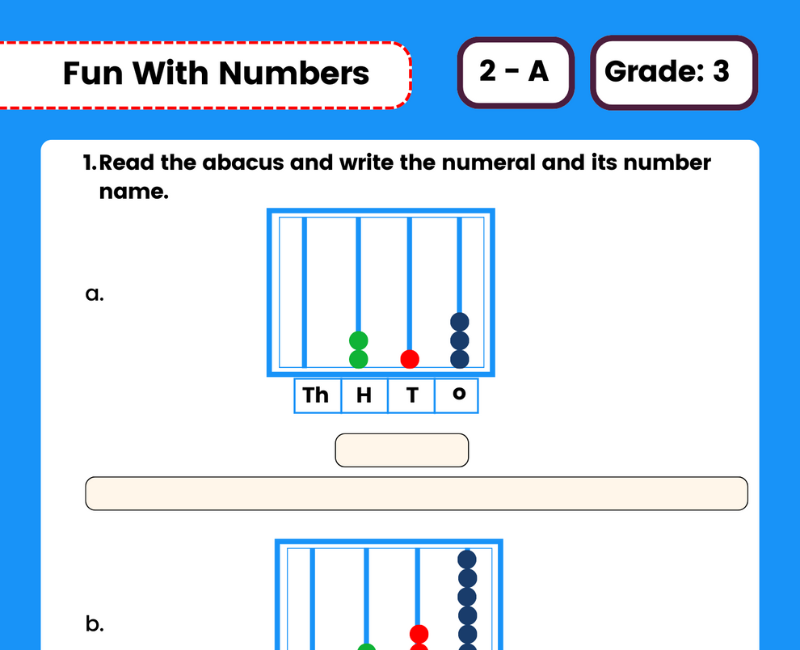Divisibility Rules Worksheets - 2 to 12 (With Explanation & Q&A)
Learning the divisibility rules is an important part of basic mathematics. To help you get a handle on them, these worksheets include step-by-step instructions along with explanations and questions and answers for each rule from 2 to 12.
Divisibility rules for
numbers 2 to 12 with examples:
Divisibility by 2:
A number is divisible by 2 if its units digit is even (0, 2, 4, 6, or 8). Example: 632 is divisible by 2 because its units digit is 2.
Divisibility by 3:
A number is divisible by 3 if the sum of its digits is
divisible by 3. Example: 315 is divisible by 3 because 3 + 1 + 5 = 9, which is
divisible by 3.
Divisibility by 4:
A number is divisible by 4 if its last two digits form a
number that is divisible by 4. Example: 736 is divisible by 4 because 36 is divisible
by 4.
Divisibility by 5:
A number is divisible by 5 if its units digit is either 0
or 5. Example: 350 is divisible by 5 because its units digit is 0.
Divisibility by 6:
A number is divisible by 6 if it is divisible by both 2 and
3. Example: 894 is divisible by 6 because it is divisible by 2 and the sum of
its digits is divisible by 3 (8 + 9 + 4 = 21, which is divisible by 3).
Divisibility by 7:
If the last digit of the number is doubled and subtracted
from the rest of the number and this difference is divisible by 7. Example
315, Double
the last digit 5 X 2 = 10
Subtract rest
of the number by 10 = 31 -10 = 21
And 21 is
divisible by 7, therefore 315 is divisible by 7.
Divisibility by 8:
A number is
divisible by 8 if its last three digits form a number that is divisible by 8.
Example: 1736 is divisible by 8 because 736 is divisible by 8.
Divisibility by 9:
A number is divisible by 9 if the sum of its digits is
divisible by 9. Example: 207 is divisible by 9 because 2 + 0 + 7 = 9, which is
divisible by 9.
Divisibility by 10:
A number is divisible by 10 if its units digit is 0.
Example: 940 is divisible by 10 because its units digit is 0.
Divisibility by 11:
There is a simple rule for determining whether a number is divisible by 11: alternate adding and subtracting digits from left to right. If the resulting number is divisible by 11, then the original number is also divisible by 11.Example: 9463 is divisible by 11 because 9 - 4 + 6 - 3 = 8, which is divisible by 11.
Divisibility by 12:
A number is divisible by 12 if it is divisible by both 3 and 4. Example: 360 is divisible by 12 because it is divisible by 3 and its last two digits form a number that is divisible by 4.
Questions and Answers Practice Sheet on Divisibility Rules from 2-12.
With this divisibility rule worksheet, you are given a set of 20 questions ranging from basic to more complex. It takes a multi-step approach for each question within each range in order familiarize you with the various rules.
First, it will ask easier questions which require identifying if some numbers are divisible by another number in the range specified.
Following that, you must answer more complex problems which involve pairs of two different numbers and whether one is divisible by the other or not. This practice sheet provides step-by-step explanations and examples to give you an understanding of why each section works to inform your answers better. All those combined make this an ideal resource for mastering comprehensive knowledge on divisibility rules in mathematics.
If you are a teacher or parent looking for resources to help your child master the concept of divisibility, then you have come to the right place. This article focuses on divisibility worksheets and rules that can aid students in understanding how to check if one number is divisible by another. By practicing these worksheets, students can gain a deeper understanding of divisibility, which is essential in solving complex math problems.
Divisibility rules are a set of guidelines that help in determining whether a number is divisible by another number without the need for division. These rules are based on the last digits of a number, its factors, and prime factorization.
The divisibility worksheets are designed to help students learn these rules through a series of exercises and practice problems. The worksheets cover a range of topics, including the divisibility rules for numbers 2 through 12, the divisibility by 11 rule, and the divisibility rule of 7.
The worksheets are available in various formats, including printable versions and PDFs, making them easily accessible for both teachers and students. Additionally, the divisibility rules chart is an excellent resource that can aid students in understanding the rules and their applications. The chart is easy to use and provides clear examples of the rules, which can help students in solving problems with ease.
One of the key benefits of using divisibility worksheets is that they help students in developing problem-solving skills. The worksheets include a variety of exercises and practice problems that enable students to apply their knowledge of the rules in real-world scenarios. Through these exercises, students can sharpen their reasoning and logical thinking skills, which are crucial in mathematics and other fields.
Moreover, the divisibility worksheets are an excellent tool for self-assessment. Students can use these worksheets to evaluate their understanding of the rules and identify areas where they need more practice. This enables them to focus on their weaknesses and improve their skills, which is crucial for academic success.
In conclusion, the divisibility worksheets and rules are essential tools that can aid students in developing a deeper understanding of divisibility. With a variety of formats available, including printable versions, PDFs, and charts, these resources are accessible and easy to use. By practicing these worksheets, students can improve their problem-solving skills, build their confidence, and excel in math.
Divisibility Test important questions with solutions
Is 2456 divisible by 4?
Solution: To check whether 2456 is divisible by 4, we need to look at its last two digits, which are 56. Since 56 is divisible by 4, we can conclude that 2456 is also divisible by 4.
Is 3048 divisible by 3?
Solution: To check whether 3048 is divisible by 3, we need to add up its digits: 3 + 0 + 4 + 8 = 15. Since 15 is divisible by 3, we can conclude that 3048 is also divisible by 3.
Is 3721 divisible by 7?
Solution: To check whether 3721 is divisible by 7, we can use the divisibility rule for 7, which states that we can subtract twice the last digit of a number from the rest of the number, and if the result is divisible by 7, then the original number is also divisible by 7. In this case, we have 372 - 2 x 1 = 370, which is divisible by 7. Therefore, we can conclude that 3721 is also divisible by 7.
Is 5148 divisible by 6?
Solution: To check whether 5148 is divisible by 6, we need to check if it is divisible by both 2 and 3. Since the last digit of 5148 is even, it is divisible by 2. To check if it is divisible by 3, we can add up its digits: 5 + 1 + 4 + 8 = 18. Since 18 is divisible by 3, we can conclude that 5148 is also divisible by 6.
Is 120 divisible by 10?
Solution: To check whether 120 is divisible by 10, we need to check if its last digit is 0. Since the last digit of 120 is 0, we can conclude that it is divisible by 10.
Is 364 divisible by 4?
Solution: To check whether 364 is divisible by 4, we need to look at its last two digits, which are 64. Since 64 is divisible by 4, we can conclude that 364 is also divisible by 4.
Is 231 divisible by 11?
Solution: To check whether 231 is divisible by 11, we can use the divisibility rule for 11, which states that we can subtract the sum of the digits in odd places from the sum of the digits in even places, and if the result is divisible by 11, then the original number is also divisible by 11. In this case, we have 2 - 3 + 1 = 0, which is divisible by 11. Therefore, we can conclude that 231 is also divisible by 11.






